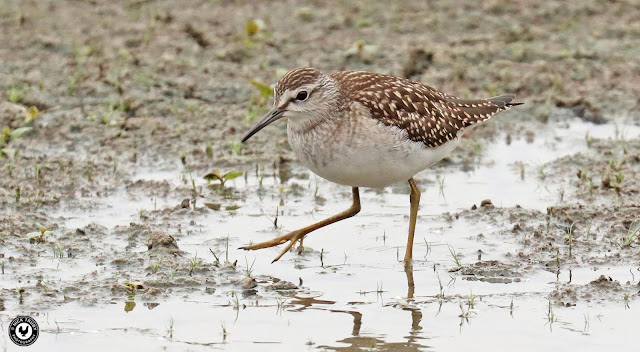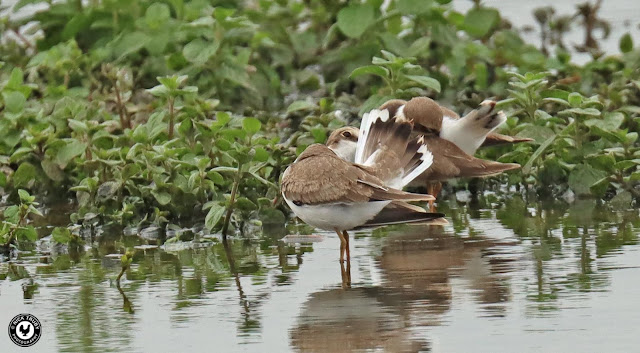I find a rare bird and then…..Forget all about it!
We hadn't been to Slimbridge since February this year, for a large part of spring the WWT reserve was closed to visitors anyway owing to the Covid crisis, and we were keen to spend a few hours there despite the ongoing restrictions that were in place. During the week another of my favourite wading birds, a Wood Sandpiper, had been spotted there as well as other good birds including a couple of Cattle Egrets, and a Spotted Redshank. To visit Slimbridge at the moment you have to book online and reserve a place, whether paid up members or not. I only booked our places at seven o'clock on the Saturday morning and we left home an hour or so later for the seventy-five minute drive. What a moment of inspiration that proved to be!
We duly passed through the Covid check in procedure and made our way directly to the Hogarth Hide overlooking a section of the South Lake where I knew the Wood Sandpiper had been seen on the previous few days. We were delighted to see the grounds and pathways devoid of people and crowds and thought; this would be good, we're the only birders here! Of course we weren't and our bubble was burst when we neared the hide and found four other folks, including our friend Clive, waiting patiently to enter. The Hogarth Hide which usually accommodates around twenty birders was now limited to just four at any one time and there were already that many inside. The couple in line at numbers three and four decided quite quickly that they had waited long enough and left saying they'd come back later when less busy. If only they knew what would unfold during the day. We took their places in the queue and wiled away the time chatting to Clive and his partner about birds and photography. After fifteen minutes they got their chance when two birders left the hide. Apparently the Wood Sandpiper was still showing occasionally according to one of the leavers so at least we knew that we had something to wait on for. A trifle deviously perhaps, I stuck my head through the door to see what the situation inside was like and almost straight away another incumbent, hopefully I hadn't made him feel uncomfortable, left leaving a space. Considering that Mrs Caley and I are as one I decided that we'd both go in and take the place, so we were in, and only after about twenty-five minutes of waiting which seemed like a decent result.
Looking out of our window from the hide, the South Lake was on our left and contained the main Black-tailed Godwit flock, Ruff, Lapwing and lots of Gulls, while to our right was a narrow and shallow channel which is where I expected the Wood Sandpiper to be. Initially though, there were just a few Green Sandpipers feeding at the edge of the muddy scrape. As we talked about recent birding trips and highlights with Clive, the Wood Sandpiper walked into view right at the end of the channel. Even though it wasn't our first of the year, we had seen one on Otmoor back in the Lockdown period, it was still an exciting bird to see. This bird was a juvenile and a very bright and fresh individual to boot, contrasting with the much darker plumage of the Green Sandpipers. I took a few record shots of the bird and then studied it through the scope. That was when the real story of the day started.
 |
| Wood Sandpiper |
 |
| The Wagtail |
 |
| Citrine Wagtail, courtesy of Paul Masters |
 |
| Citrine Wagtail & Wood Sandpiper (proof that I had noticed the Wagtail since that is in better focus!) |
Stuff that I do know!
So back to the events of the day. After the Wood Sandpiper and Citrine Wagtail had disappeared we were entertained by around seven Green Sandpipers. At first they fed at the end of the channel where we'd seen the other two birds and were too distant for good views and photos but after a while a couple of them ventured along the muddy edge and came towards us in the hide. Every time a different bird emerged from around the hidden corner the end of the channel the other birders would ask, "Is that the Wood Sandpiper?". Obviously that bird had captivated a lot of folks interest. But for half an hour or so it was just Green Sandpipers, and a Ruff, that showed and there was no sign of the Wood Sandpiper at all. I waited until one of the Green Sandpipers made it almost to the pool in front of the hide before taking photos.
 |
| Green Sandpiper |
 |
| Ruff |
 |
| Wood Sandpiper |
Now my camera arm took over and over the next fifteen minutes I rattled off nearly two hundred frames as the bird eventually reached the pool by the hide and fed alongside the Ruff and a couple of Green Sandpipers. Maybe the birds just needed the quietness of the now silent hide to gain the confidence to be more daring. I stopped taking photos and watched the Wood Sandpiper, which was providing my best ever views of the species, even eclipsing those of a close up and sleepy bird that we saw at Frampton Marsh after the Birdfair a couple of years ago.
Wood Sandpipers are small but longish-legged waders that elegantly pick their way through shallow water and muddy margins. They are quite brightly coloured birds for the family group with a prominent supercilium and spotting to the upper parts. The legs are yellowish and it sports a finely barred tail. Wood Sandpipers are slightly smaller than a Green Sandpiper, and are more rakish than that bird, but a trifle bigger than a Common Sandpiper, owing to its longer legs and more upright gait. It's a size down from a Redshank but one up from the smaller waders such as Dunlin. As I willed the Wood Sandpiper on it just crept closer and closer so that in the end I was gaining full frame images.
Our fun was finally brought to an abrupt halt when we were joined in the hide by a young couple with two very young children. Children are obviously exempt from the four in a hide rule it would seem. To their credit it wasn't them making a racket but more their parents who loudly kept them in check. The birds were aware in an instant at the increased noise, looking alarmed, and then as soon as one of the newcomers reached one of the hide windows, the Wood Sandpiper and its mates all flew off towards the main lake. The inevitable question followed, "What's about?", "Nothing much really" was my reply.
We left and went for our coffee and after having queued for nearly fifteen minutes all thoughts of the Wagtail were well and truly removed from my mind. I checked through the Wood Sandpiper photos and tweeted one out but, because the best shots came later, I never scrolled back far enough to get a memory trigger of the Wagtail. The coffee was good, even if it was taken next to the adventure playground which was absolutely rammed with noisy youngsters and even noisier parents. It seemed to me that out of hundreds of visitors to Slimbridge that day, only a very small proportion were birdwatchers, proving that the WWT's success doesn't actually depend on the bird loving public but more with engaging and entertaining Millennials and their offspring.
On our way to the coffee stop I had stopped to watch a Moorhen lovingly tend to a chick, feeding it small morsels of food. All chicks of the Rail and Crake family have faces that only a mother could love. Most are shaggily coated and a few have sparse head feathering. They all have oversize feet and long legs, necessary of course for adaptation in their watery homes. Moorhens are everywhere at Slimbridge, seemingly in every stream and even helping the Wood Pigeons and Mallards hoover up spilt seed dropped by the many visitors to the "zoo" side of the site.
 |
| Moorhen |
 |
| Common Cranes |
 |
| Little Ringed Plovers |
 |
| Ruff & Black-tailed Godwits |
 |
| Black-tailed Godwit |
We took a look out from the Rushy Hide on our way to the gate but the expected glut of birds weren't there. The same was true of the outlook from the other hides nearby, where vegetation had grown to an extent that there was no open leads of water in front of the hides. With staff furloughed during Lockdown I guess that non-essential tasks like grass trimming had been understandably shelved for the summer. I think we'll all be glad when normality resumes in our lives, if it ever can. At least the birds continue their own lives unaffected by the new problems in the Human world.
Misty morning, Muswell Hill, so it's back to Farmoor again!
Sunday morning was spent ambling around Farmoor in the warm sunshine. We had initially gone up to our local migration "hotspot" at Muswell Hill but at the top it was thick fog! Visibility was down to just a few metres and we couldn't even see the sheep bleating away in the field by the road. After a bird free ten minutes we thought it would be better to try Farmoor instead. Unfortunately the foggy weather on Muswell Hill translated into the dreaded windless and still conditions at Farmoor, the worst state for attracting birds to the reservoir. It was almost certain that there'd be nothing much of note to see.
The Grey Heron was still stood sentinel at the marina. There is a glut of small fry around the reservoir at the moment and many birds are taking advantage of the bounty. The Heron must have fed already though and was digesting its meal. Resting in warm morning sunshine after a fine breakfast is a pleasure shared by many creatures including me!
 |
| Grey Heron |
 |
| A few of the hundreds of Coots |
 |
| Common Tern |
 |
| stricken Yellow-legged Gull |
 |
| Cormorant |
 |
| Carrion Crow |
































Not sure about first for Gloucs as there were two adult Citrine Wags at Pilning in 2019 so maybe first at Slimbridge.
ReplyDeleteApparently Pilning is in South Glos recording area. According to MK this was the first for Glos recording area.
Delete